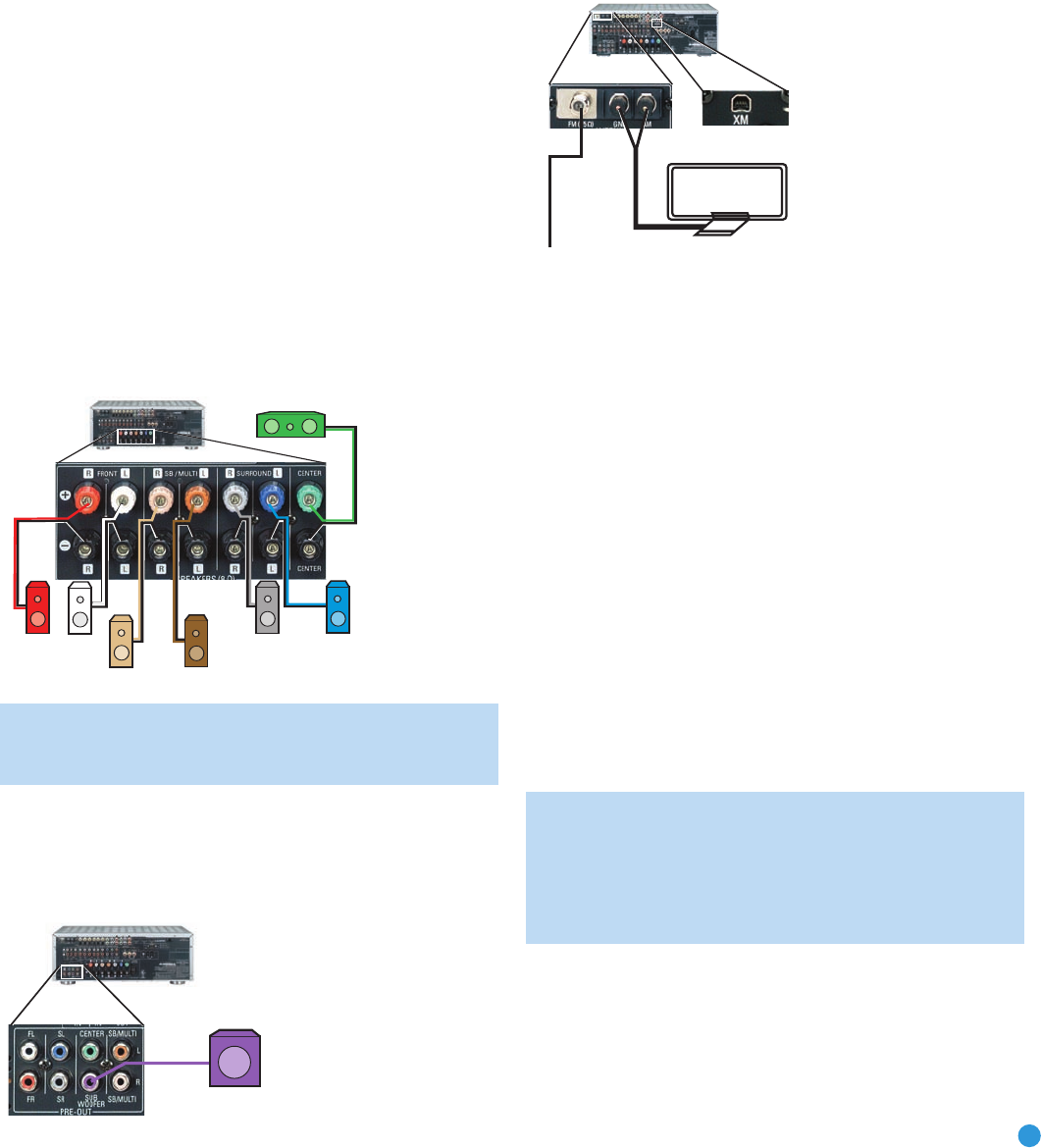
23
INSTALLATION
You are now ready to connect your various components to your receiver.
Before beginning, make sure that all components, including the AVR 247,
are turned completely off and their power cords are unplugged. Don’t
plug any of the power cords back in until you have finished
making all of your connections.
Remember that your receiver generates heat while it is on. Select a
location that leaves several inches of space on all sides of the receiver.
It is preferable to avoid completely enclosing the receiver inside a
cabinet. It is also preferable to place components on separate shelves
rather than stacking them directly on top of the receiver. Some surface
finishes are delicate. Try to select a location with a sturdy surface finish.
Step One – Connect the Speakers
If you have not yet done so, place your speakers in the listening room,
as described in the Speaker Placement section above.
Connect the center, front left, front right, surround left, surround
right, surround back left and surround back right loudspeakers to the
corresponding speaker terminals on the AVR 247. See Figure 17.
Remember to maintain the proper polarity by always connecting the
positive and negative terminals on each speaker to the positive and
negative terminals on the receiver. Use the Connection Color Guide
on page 17 as a reference.
Figure 17 – Speaker Connections
NOTE: If you only have one surround back speaker, wait until
after you have run EzSet/EQ in the Initial Setup section before
connecting it to the Surround Back Left speaker outputs.
Step Two – Connect the Subwoofer
Connect the Subwoofer Output on the AVR 247 to the line-level input on
your subwoofer. See Figure 18. Consult the manufacturer’s guide for the
subwoofer for additional information.
Figure 18 – Subwoofer Connection
Step Three – Connect the Antennas
Connect the FM and AM antennas to their terminals. If you have purchased
an XM antenna module designed for connection to an XM Ready device,
such as the AVR 247, you may connect it now. To enjoy XM Radio,
remember to purchase a subscription and activate your antenna module.
More information is available at www.xmradio.com.See Figure 19.
Figure 19 – Antenna Connections
Step Four – Connect the Source Components
Use the Table A4 worksheet in the Appendix to note which connections
you will use for each of your source devices.
For each source, select a source input (Video 1, Video 2, Video 3, etc.).
In Table 2 we recommend connecting certain types of sources to certain
source inputs to make it easier to program and use the remote control.
Decide which audio connections you will use. If your source device has
them, use one of the HDMI, coaxial digital or optical digital audio connec-
tions. Referring to Table 2, we recommend you connect the DVD source
to the Coaxial 1 input jack, and the source designated Video 2 to the
Optical 1 input jack. If you are using the HDMI inputs, then in most cases
no other audio connection is required. If your source outputs video but
not audio via its HDMI connection, then select any available coaxial or
optical digital audio input on the AVR to use with the source. If your HDMI
source plays DVD-Audio, SACD, HD-DVD, Blu-ray Discs or another multi-
channel audio format, connect its multichannel analog audio outputs to
the AVR 247’s 6-/8-Channel Inputs, and connect one of its analog video
outputs to a source input on the AVR 247 (e.g., Video 3). When you
select that source input, e.g., Video 3, select the 6-/8-Channel Inputs,
and the AVR will automatically use the analog video input.
NOTE: The multichannel analog audio connection is not
required for DVD-Audio players compliant with HDMI version
1.1 or better, or HD-DVD and Blu-ray Disc players that decode
the digital audio internally and output linear PCM signals in
digital format. Consult the owner’s guide for your disc player
for more information.
In addition to the digital audio connections, we recommend that you
connect the analog audio connections for each source, as a backup to
the digital connections, for recording, for use with the multiroom system,
or in the event that you use all six of the digital audio inputs for other
devices. For sources that don’t have digital audio outputs, you must use
the analog audio connections.
FM
AM
AVR 247
SUB
AVR 247
AVR 247
SR
SL
FR FL
SBR
SBL
C
AVR247om.qxd 7/10/07 1:05 PM Page 23


















